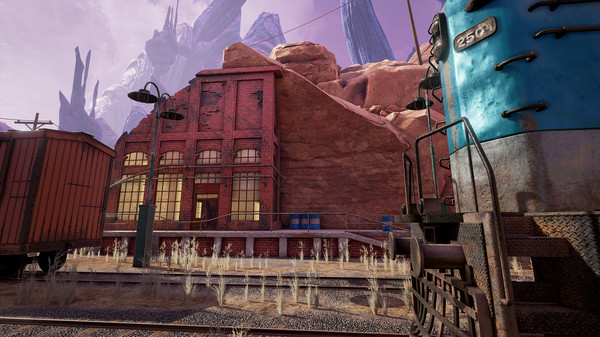Complaints Arise Over 'Obduction' Performance Issues, Cyan Pledges To Optimize
Last Halloween, Cyan added support for seated VR with gamepad locomotion to Obduction for Oculus Rift only. Yesterday, Cyan released an update that brought motion control support for Vive and Oculus Touch to the game. It also brought performance issues.
The news of motion control support was exciting, but that was short-lived. Shortly after the Obduction update went live, people started reporting performance issues in the game when playing with a Vive headset. Gamers with high-end PCs claimed that reprojection would kick in regularly, even with lowered graphics settings. Reddit user kommutator said that the game is “almost unplayable” on his PC, which includes an Intel Core i7-7700K operating at 4.66GHz and a GTX 1080 graphics card. And he isn’t alone. Several comments surfaced online about similar issues.
We gave the game a run on our Vive test bench, which is equipped with an Intel Core i5-4570K and a Gigabyte GTX 1080 G1 Gaming, and we can confirm that we found performance problems ourselves. Even with the graphics settings turned all the way down to low, the frame rate did not feel smooth. We haven’t run the game through FCAT VR yet, so we can’t say how often reprojection kicked in, but it happened regularly. It’s easy to tell that reprojection is in use when you use the teleport feature because the animation doesn’t appear as smooth as it should.
Cyan is aware of the performance complaints from its fanbase. We reached out to the developer for a comment about the situation and to see if it had a clear idea of how to move forward with a remedy. Cyan acknowledged that the game demands a high-performance system, but its response left something to be desired. The developer appears to be claiming that the problem is a hardware limitation, rather than a software limitation. The company said it would “continue to optimize,” but we get the impression that smooth gameplay in Obduction on a Vive won’t occur until we see further advancement in GPU performance—especially if you want the graphics settings turned up.
In a statement to Tom's Hardware, Ran Miller, Cyan's CEO, said:
We're reading all comments! Like we did with PC and Rift, we'll continue to update and optimize Obduction for Vive. Being a small indie dev, we can test some combinations of hardware, but it's not until release that some issues show up. Obduction VR definitely takes some horsepower to run, but we've found that adjusting settings can usually provide a satisfactory experience for most situations, and we'll continue to optimize. (And of course make sure your drivers are the latest and greatest.)As for navigation - we realize that in these early days of VR that almost everyone has a different preference depending on their performance, comfort, and experience. We will continue to add options so that each player can get the navigation experience that suits them.Thanks for the comments and support!
Get Tom's Hardware's best news and in-depth reviews, straight to your inbox.
Kevin Carbotte is a contributing writer for Tom's Hardware who primarily covers VR and AR hardware. He has been writing for us for more than four years.
-
Jeff Fx You just saved me from being annoyed by a poorly-performing game tonight. I'll try it in VR once they improve the performance.Reply -
Verrin This game never ran well for me, not even considering VR. I dunno if it just doesn't like AMD cards or what, but stutters and frame drops were common in my play through, even on lowest settings. I still worked through the issues though since there's a great game underneath all the technical flaws. Although I imagine those issues are only magnified when you add VR to the mix.Reply -
cryoburner I think it comes down to Cyan trying to push really nice visuals, while originally coming from a background in pre-rendered graphics. The original Myst games made use of pre-rendered viewpoints and bits of full-motion video to enable graphics far beyond anything realtime game engines were capable of at the time. When they decided to transition to realtime graphics, they wanted to maintain as much of that visual fidelity as possible, and as a result, their games tend to be rather demanding on hardware. This was true even back in 2000, when they launched the original RealMyst, which brought Myst into a 3D game engine, but ran poorly on most computers at the time, and it's kind of been a trend they've had since.Reply
And at least in Obduction's case, they're back down to a relatively small development team, while making a game that has visuals comparable or better than what you might find from much larger teams. Unfortunately, that apparently comes at the cost of optimization, although the game's slow pace means than getting only around 30 fps should still be plenty playable, at least on a monitor. That doesn't really work as well in VR though, where 90+ fps is ideal.
And no, it's not just AMD hardware. Even some with high-end Intel i7 processors and $500+ Nvidia GTX 1080 cards are complaining about the performance in VR. I'm sure there must be room for performance improvements though, so things will likely get better, at least to some degree.
